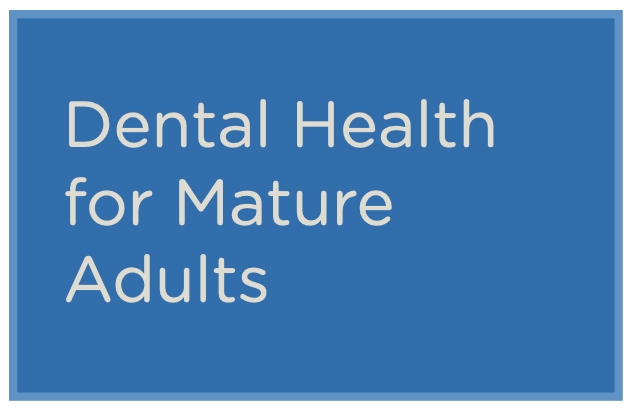

A lifetime of efforts toward maximizing dental health can really pay dividends as we age. But what are the natural consequences of dental aging? Most of the chronic dental diseases like gingivitis and periodontal disease are no longer an issue, but other concerns such as decay at the root, failing restorations, and dry mouth take over as important things to manage. This segment of the website is geared to help the mature adult take control over any issues that may develop.
Dry Mouth
Every-day medications causing dry mouth include anti-hypertensives (blood pressure medications), anticholinergics (for things like COPD or overactive bladder), decongestants and antihistamines (allergy blockers). Surprisingly one of the worst cases of dry mouth I have seen is from an asthma inhaler. Chemotherapy drugs in general also have the same dry mouth effect; for anyone who has had targeted radiation therapy to the head or neck, dry mouth is likely to be a severe complaint. Another cause of dry mouth is Sjogren’s syndrome – an autoimmune disorder which can make the eyes and mouth dry and frequently happens along with eczema and arthritis.
Regardless of the cause of the dry mouth, it is very important to manage correctly. Chronic dry mouth shifts the oral biome, allowing a greater number of decay-causing bacteria to populate the teeth, tongue and throat. PLEASE, do not use regular hard candies to soothe your dry mouth! These usually are loaded in sugar – just a single lemon drop has 9 grams of sugar, which is one third the total amount of sugar recommended per day for adults! AND – as soon as they melt, the dry mouth continues and another candy is needed. Even the sugar free candies have a low pH – low enough to directly acid-etch the remaining hard tooth structure as well as indirectly damage the tooth by further supporting overgrowth of decay-causing bacteria. If the sugar free candy is sweetened with sorbitol, that can cause GI cramping and upset the gut microbiome.
The best management for dry mouth is avoiding caffeine and alcohol, and sipping water throughout the day. Using a humidifier at night can be helpful. Oral stimulation through xylitol containing hard candies periodically can help – and if they are minty, they have the added benefit of clearing the nasal passages without decongestant medication! Saliva substitutes are needed in more extreme cases; Biotene makes and oral balancing gel that is available over the counter and PerioSciences makes an AO gel that contains antioxidants and essential oils to soothe a dry mouth.
Root Decay
A natural consequence of aging is gum recession, leading to exposure of the tooth root. The root of our teeth are not covered by enamel and are therefore more prone to decay. Prevention of root decay is the goal! Many mature adults benefit from more frequent dental cleanings as well as customized home dental care routines. If the root of the tooth is exposed, the tooth becomes much trickier to clean than before. Mouthwashes, Fluorides and regenerative Calcium pastes cannot penetrate plaque. Electric toothbrushes and water flossers are excellent adjuncts to the traditional toothbrush and floss for removing plaque.
If root decay occurs, timely treatment is advised. Root decay usually occurs in small eroded areas under the neck of the tooth. Very conservative dentistry can both remove the decay and improve the contour of the tooth, making it more easily maintained at home. When root decay occurs at the neck of a tooth with an existing crown, replacing the crown is the only way to fully expose the depth of decay and ensure its removal.
Failing Restorations
Dental fillings and crowns/bridges have a lifespan of their own. Silver-Mercury amalgam fillings will almost always leak after years of thermal cycling between hot foods and cold liquids, and the corrosion that occurs at the border also creates concern of Mercury toxicity (though most Mercury toxicity is thought to come from eating deep salt water fish). Due to the engineering needed to place Silver-Mercury fillings, it is not unusual for a portion of the tooth to crack off around a long-standing Silver-Mercury filling. This can create rough edges that are irritating to the tongue or cheek, and likely shifts the balance of the bite to a different tooth or different part of the same tooth, now placing that tooth under greater strain that it should withstand.
Dental crowns/bridges are the workhorses of restorative dentistry, lasting decades in many cases. The “gold standard” in restorative dentistry is indeed a gold alloy crown, but porcelain and ceramic materials have come a long way in providing stability for back teeth.
Darker Teeth
An unfortunate truth of becoming a mature adult is that our teeth become more intensely pigmented over time. The pulp inside the tooth continues to lay down dentin for as long as the tooth is vital. This increased density of dentin makes the tooth appear more yellow over time. The bright vitality of the enamel diminishes over time, as the exposure to acids and rough foods have both chemically and mechanically worn the enamel thinner. The combination of these two realities is that teeth become more brittle and more likely to chip or break. On the esthetic side, dental tooth bleaching is not very effective at enhancing our pearly whites.
Most people know of dental veneers as a cosmetic procedure – indeed, improved esthetics can be accomplished! The best part of veneers however is that they add back the original volume of enamel lost over the years and this serves to stiffen the teeth and protect them from fracture! How they look is entirely a personal choice…from uniform and bright white to a more tailored blended look, just about anything is possible. Click here to
